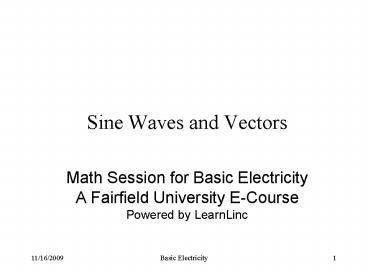Sine Waves and Vectors PowerPoint PPT Presentation
1 / 17
Title: Sine Waves and Vectors
1
Sine Waves and Vectors
- Math Session for Basic ElectricityA Fairfield
University E-CoursePowered by LearnLinc
2
Basic Electricity
- Two Sections
- Electron Flow and Resistance
- 5 on-line sessions
- Lab
- Inductance and Capacitance
- 5 on-line sessions
- Lab
- Mastery Test, Part 1
3
Basic Electricity(Continued)
- Text Electricity One-Seven, Harry
Mileaf, Prentice-Hall, 1996, ISBN 0-13-889585-6
(Covers several Modules and more) - References
- Digital Mini Test Principles of Electricity
Lessons One and Two, SNET Home Study
Coordinator, (203) 771-5400 - Electronics Tutorial (Thanks to Alex Pounds)
- Electronics Tutorial (Thanks to Mark Sokos)
- Basic Math Tutorial (Thanks to George Mason
University) - Vector Math Tutorial (Thanks to California
Polytec at atom.physics.calpoly.edu )
4
Section 2 AC, Inductors and Capacitors
- 0BJECTIVES This section introduces AC voltage /
current and additional circuit components
(inductors, transformers and capacitors).
5
Section 2 Schedule
Text 3.1 3.41Text 4.1 4.24 Text 3.42
3.75Text 3.76 3.100Text 3.101
3.135Text 3.135 3.148
Alternating Current Sine WavesSine Waves,
Magnitude, Phase and VectorsInductors and
CircuitsTransformersCapacitorsMore
CapacitorsReview (Discuss Quiz_2)
Session 2a 03/27Vector Math 04/01
Session 2b 04/03Session 2c
04/08Session 2d 04/10 (lab - 04/13, Sat.)
Session 2e 04/15Session 2f 04/22
6
Session 2a Review
- AC vs. DC
- Transformers
- Ohms Law
- AC Generators
- Sine Waves sin(2?ft?)
- Frequency, Period, Wavelength and Magnitude
- Phase Angle
- Averages
- Mean (DC)
- RMS (Effective Value)
7
Angle Degrees and Radians
- Degrees, minutes and seconds
- 360? gets you around a circle
- Invented by map makers in the middle ages
- Reused for Time measurements
- Radians (in calculators)
- 2 ? or 2 3.14159 gets you around a circle
- The real angle measure
- The distance traveled around the perimeter of a
unit circle (r 1)
8
Sine Waves and Angle
- V 3sine (angle)
- Sine often shortened to sin V 3sin(angle)
- 3 is the Amplitude
- Starts at zero
- Peak (3) at 90(?/2)
- Zero again at 180(?)
- Negative Peak (-3) at 270(3?/2)
- Zero to Finish the Cycle at 360(2?)
9
Phase Difference
- Waveforms can be out of phase
- Note
- sin(2?ft - ?/2) cos(2?ft)
- Cosine is the full name
- Starts at 1 at t 0
- Looks just like sine but at a different phase
10
Adding Two Sine Waves
- Adding two sine waves at the same frequency but
different phases results in a sine wave with the
same frequency, new amplitude, and new phase
Each point in the graph adds separatelyHere
the two sine waves are 90 apart.with equal
amplitude
The result is a sine wave at 45 (?/4)with an
amplitude of 1.414 (the square root of 2)
11
The Vector Analogy
- We can make the task of adding sine waves with
the same frequency easier using vectors - Treat a sine wave with Amplitude A and phase ?
as a vector of length A at an angle of ? (the
frequency is implicit)note by convention
cos(2?ft) has a zero angle
Acos(2?ft ?)
12
Adding Sine and CosineUsing Vectors
- Angle arctan(3/3) ?/4 (45)
- Length sqrt(32 32) (Pythagorus)
- Length sqrt(9 9)
- Length sqrt(92)
- Length sqrt(9)sqrt(2)
- Length 3sqrt(2)
- Length 31.414 4.243
3sin(x)
45
3cos(x)
Sum 4.243 cos(x 45)
13
Adding VectorsHead-to-Tail, Parallelogram
- Head-to-Tail Method
- Redraw vectors so that one starts where the other
ends - Draw the sum vector from the free tail to the
free head. - Good for multiple vectors
- Parallelogram Method
- Complete the parallelogram
- The sum is the diagonal of the Parallelogram
2
1
S
14
Vectors and TrigThe Unit Circle
- sin(?) opposite/hypotenuse
- cos(?) adjacent/hypotenuse
- tan(?) opposite/adjacent
- ? arcsin(opposite/hypotenuse)
- ? arccos(adjacent/hypotenuse)
- ? arctan(opposite/adjacent)
- Remember, if your calculator is in degree mode
- ? is in degrees radian mode - ? is in radians
15
Vector Components(Cartesian)
- Acos(x ?)
- Acos(?)cos(x)Asin(?)sin(x)
y
x - component
y - component
A
Asin(?)
?
Acos(x ?)
Asin(?)sin(x)y component
x
Acos(?)
Acos(?)cos(x) x component
You can add vectors by adding their components (
x1 x2, y1 y2)
16
Adding Vectors by Componentsp. 4-16
- V14?75, V22?45, V33?30
- X components
- V1x 4cos(75) 40.2588 1.035 error in book
- V2x 2cos(45) 20.7071 1.414 sqrt(2)
- V3x 3cos(30) 30.866 2.6
- Vtx 1.035 1.414 2.6 5.05
- Y components
- V1y 4sin(75) 40.966 3.86
- V2y 2sin(45) 20.7071 1.414 sqrt(2)
- V3y 3sin(30) 30.500 1.5
- Vty 3.86 1.414 1.5 6.77
- Vt 5.05i 6.77j where i and j are the
Cartesian unit vectorsVt 8.5 ? 53
- Changing Component Form into Sign-Magnitude Form
- Find the Magnitude
- A ?(5.05)2 (6.77)2
- A ?72.3 8.5
- Find the Angle
- arctan(6.77/5.05)
- arctan(1.34)
- 0.93 radians
- 0.93180/? 53.3
17
Section 2 Schedule
Text 3.1 3.41Text 4.1 4.24 Text 3.42
3.75Text 3.76 3.100Text 3.101
3.135Text 3.135 3.148
Alternating Current Sine WavesSine Waves,
Magnitude, Phase and VectorsInductors and
CircuitsTransformersCapacitorsMore
CapacitorsReview (Discuss Quiz_2)
Session 2a 03/27Vector Math 04/01
Session 2b 04/03Session 2c
04/08Session 2d 04/10 (lab - 04/13, Sat.)
Session 2e 04/15Session 2f 04/22

